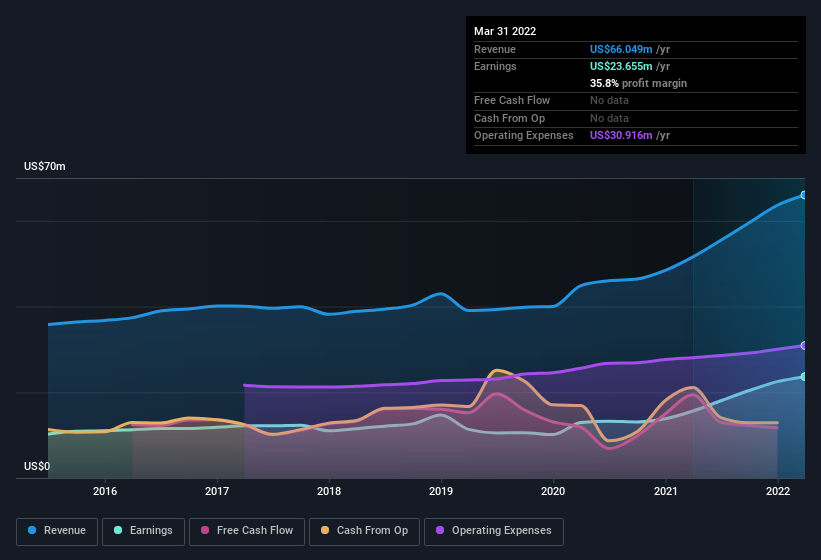I Ran A Stock Scan For Earnings Growth And Bank of Princeton (NASDAQ:BPRN) Passed With Ease
It's only natural that many investors, especially those who are new to the game, prefer to buy shares in 'sexy' stocks with a good story, even if those businesses lose money. Unfortunately, high risk investments often have little probability of ever paying off, and many investors pay a price to learn their lesson.
So if you're like me, you might be more interested in profitable, growing companies, like Bank of Princeton (NASDAQ:BPRN). Even if the shares are fully valued today, most capitalists would recognize its profits as the demonstration of steady value generation. While a well funded company may sustain losses for years, unless its owners have an endless appetite for subsidizing the customer, it will need to generate a profit eventually, or else breathe its last breath.
Check out our latest analysis for Bank of Princeton
How Quickly Is Bank of Princeton Increasing Earnings Per Share?
If you believe that markets are even vaguely efficient, then over the long term you'd expect a company's share price to follow its earnings per share (EPS). It's no surprise, then, that I like to invest in companies with EPS growth. Impressively, Bank of Princeton has grown EPS by 30% per year, compound, in the last three years. If the company can sustain that sort of growth, we'd expect shareholders to come away winners.
Careful consideration of revenue growth and earnings before interest and taxation (EBIT) margins can help inform a view on the sustainability of the recent profit growth. Not all of Bank of Princeton's revenue this year is revenue from operations, so keep in mind the revenue and margin numbers I've used might not be the best representation of the underlying business. While we note Bank of Princeton's EBIT margins were flat over the last year, revenue grew by a solid 28% to US$66m. That's progress.
You can take a look at the company's revenue and earnings growth trend, in the chart below. Click on the chart to see the exact numbers.
Fortunately, we've got access to analyst forecasts of Bank of Princeton's future profits. You can do your own forecasts without looking, or you can take a peek at what the professionals are predicting.
Are Bank of Princeton Insiders Aligned With All Shareholders?
Like that fresh smell in the air when the rains are coming, insider buying fills me with optimistic anticipation. This view is based on the possibility that stock purchases signal bullishness on behalf of the buyer. Of course, we can never be sure what insiders are thinking, we can only judge their actions.
Any way you look at it Bank of Princeton shareholders can gain quiet confidence from the fact that insiders shelled out US$405k to buy stock, over the last year. And when you consider that there was no insider selling, you can understand why shareholders might believe that lady luck will grace this business. Zooming in, we can see that the biggest insider purchase was by Martin Tuchman for US$119k worth of shares, at about US$29.85 per share.
Along with the insider buying, another encouraging sign for Bank of Princeton is that insiders, as a group, have a considerable shareholding. To be specific, they have US$43m worth of shares. That shows significant buy-in, and may indicate conviction in the business strategy. Those holdings account for over 23% of the company; visible skin in the game.
While insiders are apparently happy to hold and accumulate shares, that is just part of the pretty picture. The cherry on top is that the CEO, Ed Dietzler is paid comparatively modestly to CEOs at similar sized companies. For companies with market capitalizations between US$100m and US$400m, like Bank of Princeton, the median CEO pay is around US$1.5m.
Bank of Princeton offered total compensation worth US$1.1m to its CEO in the year to . That comes in below the average for similar sized companies, and seems pretty reasonable to me. CEO remuneration levels are not the most important metric for investors, but when the pay is modest, that does support enhanced alignment between the CEO and the ordinary shareholders. It can also be a sign of good governance, more generally.
Should You Add Bank of Princeton To Your Watchlist?
For growth investors like me, Bank of Princeton's raw rate of earnings growth is a beacon in the night. On top of that, insiders own a significant stake in the company and have been buying more shares. So it's fair to say I think this stock may well deserve a spot on your watchlist. You should always think about risks though. Case in point, we've spotted 2 warning signs for Bank of Princeton you should be aware of, and 1 of them makes us a bit uncomfortable.
As a growth investor I do like to see insider buying. But Bank of Princeton isn't the only one. You can see a a free list of them here.
Please note the insider transactions discussed in this article refer to reportable transactions in the relevant jurisdiction.
Have feedback on this article? Concerned about the content? Get in touch with us directly. Alternatively, email editorial-team (at) simplywallst.com.
This article by Simply Wall St is general in nature. We provide commentary based on historical data and analyst forecasts only using an unbiased methodology and our articles are not intended to be financial advice. It does not constitute a recommendation to buy or sell any stock, and does not take account of your objectives, or your financial situation. We aim to bring you long-term focused analysis driven by fundamental data. Note that our analysis may not factor in the latest price-sensitive company announcements or qualitative material. Simply Wall St has no position in any stocks mentioned.

 Yahoo Finance
Yahoo Finance 
